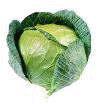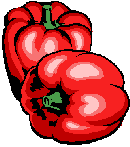
Also call:

 | DESCRIPTION
|
Cabbage has a compact head form by leaves and it is
related to Broccoli, Brussel Sprouts and Cauliflower.
 | HISTORY AND ORIGIN
|
The Cabbages has been dated back to the Ancient Greek and
it is been thought to been cultivated in the Asia minor and Eastern
Mediterranean. The word Cabbage is a form of a French word 'Carboche'
meaning head.
 | BUYING AND STORAGE
|
Choose firm, crisp head and heavy for it size, with bright
colour leaves. Store in refrigerator and will last for 7 days.
 | PREPARATION AND USE
|
Remove any discoloured leaves, rinse in cold water. Cut as
required. Use raw in salad, coleslaw, or pickled. Can be stir-fry or boiled.
 | NUTRITIONAL INFORMATION
|
An excellent source of vitamin C and a good source of
folate. Raw Cabbage contains more vitamin C and folate.
 | MAJOR NUTRIENTS
|
- SERVING SIZE: 100 grm
* ENERGY:
100
kj
* CALCIUM:
* PROTEIN: 2
grm
* VITAMIN A:
* FAT: 3
grm
* VITAMIN B:
* CARBOHYDRATES: 6
grm
* VITAMIN C: 48 mg
* DIETARY FIBRE:
4 grm
* SODIUM:
16 grm
* IRON:
 | VARIETY
|
DANISH: Solid head with a round oval
in shape, closely compacted with smooth leaves and green in colour.
 DOMESTIC: Loosely formed head with leaves that are
tender, brittle and curled and does not overlap. Has a cream/white/green in
colour. DOMESTIC: Loosely formed head with leaves that are
tender, brittle and curled and does not overlap. Has a cream/white/green in
colour.
POINTED: A pointed coned head Cabbage with smooth leaves
and pale green in colour.
 RED: Looks like a normal Cabbage with smooth leaves,
round head and red/purple leaves. RED: Looks like a normal Cabbage with smooth leaves,
round head and red/purple leaves.
 SAVOY: Very crinkle leaves and loosely formed
head, yellow/green in colour and sweet flavour. SAVOY: Very crinkle leaves and loosely formed
head, yellow/green in colour and sweet flavour.
|





DOMESTIC: Loosely formed head with leaves that are tender, brittle and curled and does not overlap. Has a cream/white/green in colour.
RED: Looks like a normal Cabbage with smooth leaves, round head and red/purple leaves.
SAVOY: Very crinkle leaves and loosely formed head, yellow/green in colour and sweet flavour.